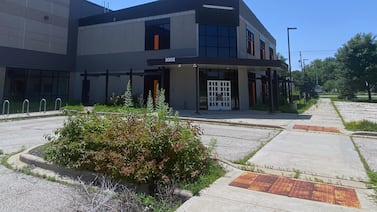After widespread printer problems in Maricopa County on Election Day, the ballots of 146 county voters are in limbo, and potentially will not be counted.
The 146 ballots are from voters who checked in at an initial vote center and received a ballot but left — potentially without casting that ballot — without being checked out by poll workers. These likely were voters whose original ballots were not accepted by the tabulator and who were unwilling to place it in a box to be counted later. They then went to a second vote center and were issued provisional ballots.
County officials say that they are researching those ballots to see which ones should be counted. They will be able to discern if the voter previously cast a ballot in the initial location, and if the voter did not, officials will count the provisional ballot, county Elections Department spokesperson Megan Gilbertson told Votebeat.
The voters could have been given a provisional ballot because poll workers did not follow training instructions telling them to check the voter out, or because the voter left before poll workers could do so. If the voters were checked out, they would have been able to vote normally at the second location and wouldn’t have been given a provisional ballot.
The procedure is a precaution designed to prevent double voting by guarding against one voter casting multiple ballots at different vote centers. Because the voter wasn’t checked out, the county has no easy way to confirm the voter didn’t already vote.
While the printer problems affected about 30% of vote centers and thousands of voters were unable to get on-site vote-counting machines to tabulate their ballots, all other affected ballots have been counted.
The county told poll workers to advise voters experiencing issues tabulating to put their ballot in a secure box, known as “door #3,” to later be tabulated at the county’s election center. Not all voters were comfortable with that option. Supervisors Chairman Bill Gates on Election Day morning reassured voters that checking out and going to a different vote center was an option.
Regardless of why or how these voters were not checked out, it now puts those ballots in purgatory for now — and potentially sets up a messy battle over whether they should have been counted.
Votes are still being counted, and the margins on a few statewide races are incredibly close, which means these votes could potentially change the outcome of a race. Attorney General candidate Kris Mayes, a Democrat, led her Republican opponent Abe Hamadeh by 148 votes as of 5:30 p.m. Thursday, with an estimated 11,074 ballots still to be counted.
These provisional ballots could form the basis of upcoming legal challenges from candidates’ campaigns. GOP gubernatorial candidate Kari Lake, who lost her election to current Secretary of State Katie Hobbs, a Democrat, has said that her campaign is partnering with Hamadeh’s campaign to consider legal challenges to the election. On Thursday, she pointed out the printer problems in a video posted on Twitter and said she “has assembled the best and brightest legal team and we are exploring every avenue to correct the many wrongs that have been done this week.”
County: Workers were trained to cancel initial ballots
The county uses an electronic system, referred to as “e-poll books,” to check voters in when they arrive at the polls. This is the only part of the voting system connected to the internet — through a private, secure connection. It shows poll workers live information about voters, such as their address and whether they have already cast a ballot in the election.
That’s how the county tracks if a voter has cast a ballot already, because ballots are anonymous and do not have any unique identifiers.
That’s why the county uses a process, outlined in a guide given to lead poll workers — known as inspectors — to check a voter out of the system if they want to leave a location after getting a ballot but before voting. The inspectors receive this guide before Election Day, Gilbertson said.
It’s the same process that the poll workers use if a voter messes up when filling out a ballot. The inspector is told to cancel, or “spoil,” the voters’ initial ballot by updating the voter’s record in the e-poll book and then putting the spoiled ballot into a special box for recordkeeping. The voter can then be checked in again at that location or another location, and receive a new ballot.
When the voter arrives at a second location, the e-poll book flags that they have already received a ballot, according to the manual. Upon check-in, a message pops up that says “The voter has already been issued a ballot for this election! Allow Reissue? Please call the hotline if you have questions.”
In the inspector training guide, the county tells inspectors to call the county’s hotline if this happens, “unless you have already been contacted regarding a cancelled check-in at a nearby location.”
“Once approved by the Hotline, select ‘Yes’ to reissue a ballot to the voter,” the training says. The training does not say how to address the situation if the hotline does not approve reissuing a second ballot, and it’s unclear whether poll workers who called the hotline were told to issue a provisional ballot or that was a step they took on their own.
The topic of how to cancel a voter’s ballot is covered in-depth at “weekly inspector workshops,” and “covered at a high level during General Election in person training for poll workers,” said Megan Gilbertson, a spokesperson for the Elections Department.
Tara Bartlett, who served as an observer for the Democratic Party, was at one of the locations in Phoenix that had problems tabulating ballots. She said she saw about five voters leave after getting a ballot and before being able to cast it, and she said workers directed them to the e-poll book stations to properly spoil their ballots before they left.
In the case of the 146 provisional ballots, county officials will research whether or not to count the ballots in a few ways, Gilbertson said. The first is by looking at the number of ballots cast at the initial location and comparing it to the number of check-ins at that location, and then looking at the same information for the second location. For example, if there are 100 check-ins at the initial location but only 99 ballots cast there, and a corresponding discrepancy at the second location where the voter checked in, then that would provide evidence the voter voted at only one of those locations. The county will also interview poll workers, Gilbertson said.
This, along with other documentation, would give the county the evidence it needed to decide if the provisional ballot should be counted, she said.
GOP warned voters not to use “Door 3”
Asked to comment on GOP claims that voters were disenfranchised by this process, Gilbertson said that when poll workers began reporting issues around 6:30 a.m., county officials immediately issued directions for poll workers to tell voters to place their ballots in door 3.
“But as the Chairman shared in the press conference on Monday, misinformation spread widely on Election Day, and it scared voters from casting their ballots in a legally valid way,” she said, alluding to comments from Republicans.
State GOP Chairwoman Kelli Ward tweeted out an image on Election Day that told voters “do not put your ballot in ‘box 3’ or ‘door 3’ … if you have not checked in and there are issues at your polling place, find the next nearest location at maricopa.vote.” That was retweeted by the state Republican Party’s account.
Bartlett witnessed voters’ fear over door 3 first hand. She said people were repeating GOP statements on social media such as “I know if I drop my ballot in there it isn’t going to be read.”
“We had multiple people get into a combative dialogue with the inspector and other election workers,” she said.
Most voters, Bartlett said, repeatedly tried to get the vote-counting machines to tabulate their ballots. If it still wouldn’t work, they would spoil their initial ballot and get a new one. Bartlett says she didn’t see a voter leave without going through that process.
GOP leaders are now trying to use online forms and emails to gather evidence from voters who believe they were disenfranchised.
On Monday, the state party tweeted an image directing people to email the party if they experienced printer problems and “tried to check in to vote at a functioning voting center and were not permitted to vote.” Hamadeh retweeted it.
“Disenfranchised? Help us vote for Arizona” Ward said in a tweet Wednesday with a link to a separate online form.






